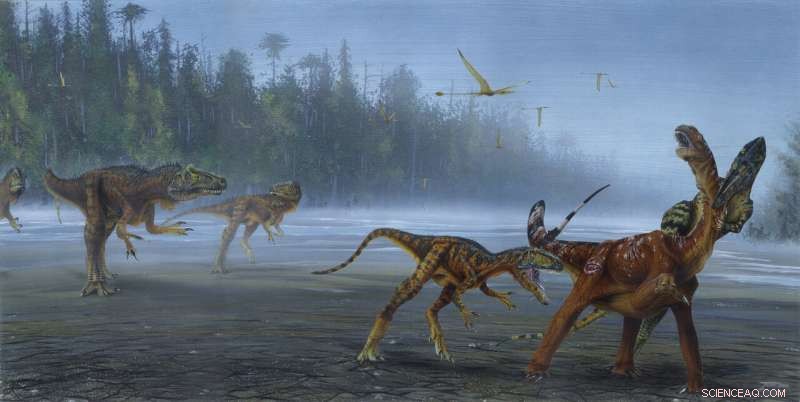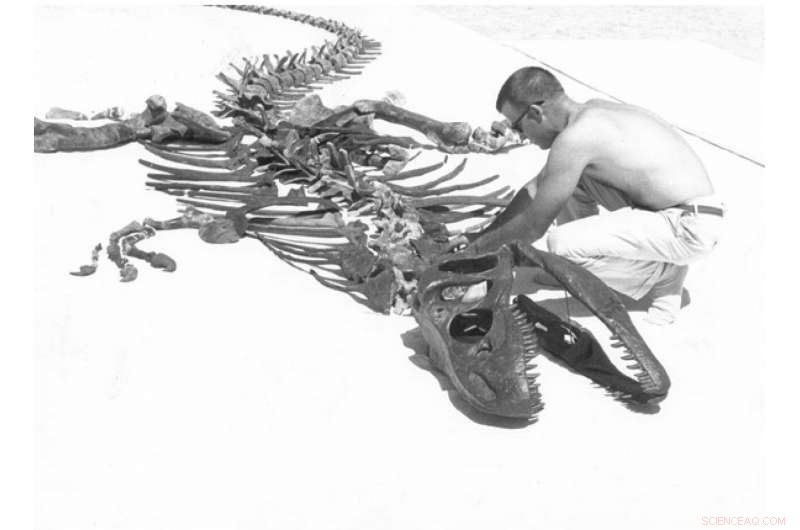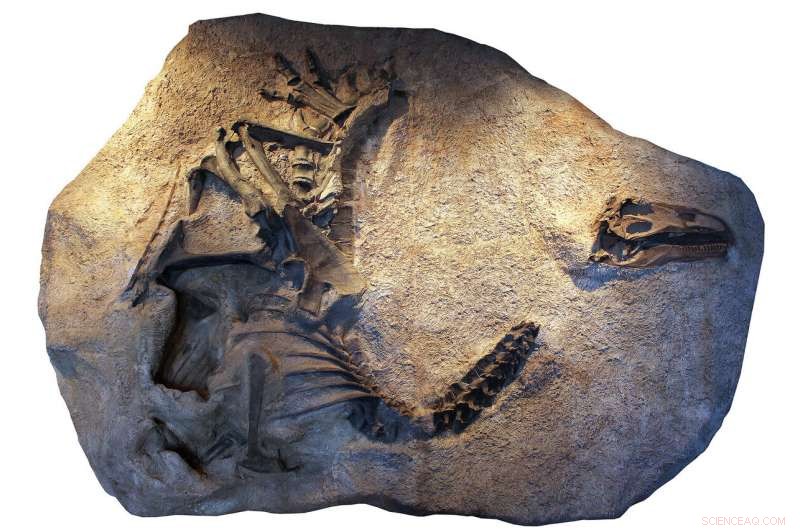
Allosaurus jimmadseni attackerar juvenil sauropod. Kredit:Todd Marshall
En anmärkningsvärd ny art av köttätande dinosaurier har avslöjats på Natural History Museum of Utah. Paleontologer grävde fram det första exemplaret i början av 1990-talet i Dinosaur National Monument i nordöstra Utah. Den enorma köttätaren bebodde översvämningsslättarna i västra Nordamerika under den sena juraperioden, mellan 157-152 miljoner år sedan, vilket gör den till den geologiskt äldsta arten av Allosaurus , före det mer välkända statsfossilet i Utah, Allosaurus fragilis . Den nyligen namngivna dinosaurien Allosaurus jimmadseni , tillkännagavs idag i den vetenskapliga tidskriften med öppen tillgång PeerJ .
Arten tillhör allosauroiderna, en grupp av små till stora, tvåbenta köttätande dinosaurier som levde under jura- och kritaperioden. Allosaurus jimmadseni , har flera unika egenskaper, bland dem en kort smal skalle med låga ansiktskam som sträcker sig från hornen framför ögonen fram till näsan och en relativt smal baksida av skallen med en plan yta till botten av skallen under ögonen. Skallen var svagare med mindre överlappande synfält än sin yngre kusin Allosaurus fragilis . Allosaurus jimmadseni utvecklats minst 5 miljoner år tidigare än fragilis, och var det vanligaste och bästa rovdjuret i sitt ekosystem. Den hade relativt långa ben och svans, och långa armar med tre vassa klor. Namnet Allosaurus översätts som "olika reptiler, "och den andra delen, jimmadseni, hedrar Utah State paleontolog James H. Madsen Jr.
Efter en första beskrivning av Othniel C. Marsh 1877, Allosaurus blev snabbt den mest kända – ja den kvintessensen – Jurassic theropod. Den taxonomiska sammansättningen av släktet har länge varit en debatt under de senaste 130 åren. Paleontologer hävdar att det finns någonstans mellan en och 12 arter av Allosaurus i Morrison-formationen i Nordamerika. Denna studie känner bara igen två arter - A. fragilis och A. jimmadseni .
"Tidigare, paleontologer trodde att det bara fanns en art av Allosaurus i Jurassic North America, men denna studie visar att det fanns två arter – den nyligen beskrivna Allosaurus jimmadseni utvecklades minst 5 miljoner år tidigare än sin yngre kusin, Allosaurus fragilis , " sa co-lead författare Mark Loewen, forskarassistent vid Natural History Museum of Utah, och docent vid institutionen för geologi och geofysik vid University of Utah ledde studien. "Skallen av Allosaurus jimmadseni är lättare byggd än sin senare släkting Allosaurus fragilis , tyder på ett annorlunda matningsbeteende mellan de två."
"Att känna igen en ny dinosaurieart i stenar som har undersökts intensivt i över 150 år är en enastående upptäcktsupplevelse. Allosaurus jimmadseni är ett bra exempel på hur mycket mer vi måste lära oss om dinosauriernas värld. Många fler spännande fossiler väntar på upptäckt i Jurassic bergarter i den amerikanska västern, sa Daniel Chure, pensionerad paleontolog vid Dinosaur National Monument och medförfattare till studien.
George Engelmann vid University of Nebraska, Omaha upptäckte ursprungligen det ursprungliga skelettet av den nya arten inom Dinosaur National Monument 1990. 1996, flera år efter att det huvudlösa skelettet samlades in, den radioaktiva skallen som tillhör skelettet med hjälp av en strålningsdetektor av Ramal Jones vid University of Utah. Både skelett och skalle grävdes ut av team från Dinosaur National Monument.
"Big Al, "ett annat exemplar som tillhör den nya arten, upptäcktes i Wyoming på United States Bureau of Land Management (BLM) mark 1991 och är inrymt i samlingarna på Museum of The Rockies i Bozeman, Montana. Tidigare trott tillhöra Allosaurus fragilis , "Big Al" var med i BBC:s 2001 "Walking with Dinosaurs:Ballad of Big Al"-video. Under de senaste 30 åren, besättningar från olika museer har samlat in och förberett material av denna nya art. Andra exemplar inkluderar "Big Al Two" på Saurier Museum Aathal i Schweiz och Allosaurus material från Dry Mesa Quarry i Colorado vid Brigham Young University.
"Denna spännande nya studie illustrerar vikten av fortsatta paleontologiska undersökningar på offentlig mark i väst. Upptäckten av denna nya taxon av dinosaurier kommer att ge viktig information om livet och tiderna för Jurassic dinosaurier och representerar en annan unik komponent av Amerikas arv, sade Brent Breithaupt, BLM regional paleontolog.

Paleontologen James Madsen Jr sätter ihop ett sammansatt skelett av Allosaurus från Clevland Lloyd Dinosaur Quarry Kredit:J. Willard Marriot Library vid University of Utah
Dinosaurier från den tidiga Morrison-formationen ersattes av några av de mest ikoniska dinosaurierna från sen jura
Allosaurus jimmadseni levde på de halvtorra Morrison Formations översvämningsslätter i det inre av västra Nordamerika. De äldre klipporna i Morrison Formation bevarar en fauna av dinosaurier som skiljer sig från den ikoniska yngre Morrison Formation faunan som inkluderar Allosaurus fragilis , Diplodocus och Stegosaurus. Paleontologer har nyligen fastställt att exemplar av denna nya dinosaurieart levde på flera platser i det västra inlandet av Nordamerika (Utah, Colorado och Wyoming).
Studiesammanfattning
Dinosaurier var de dominerande medlemmarna av terrestra ekosystem under mesozoiken. Dock, mönstret av evolution och omsättning av ekosystem under mitten av mesozoiken är fortfarande dåligt förstådd. Författarna rapporterar upptäckten av den tidigaste medlemmen av gruppen av allosauroider med stor kropp i ekosystemet Morrison Formation som ersattes av Allosaurus fragilis och illustrera förändringar som förvärvats i släktet över tid. Studien inkluderar en djupgående beskrivning av varje ben i skallen och jämförelser med kranialmaterial från andra köttätande dinosaurier. Till sist, studien känner igen bara två arter av Allosaurus i Nordamerika med Allosaurus fragilis ersätter dess tidigare släkting Allosaurus jimmadseni .
Faktablad:Viktiga punkter i tidningen
- En anmärkningsvärd ny art av köttätande dinosaurier, Allosaurus jimmadseni , beskrivs utifrån två spektakulärt kompletta skelett. Det första exemplaret grävdes fram i Dinosaur National Monument, i nordöstra Utah.
- Allosaurus jimmadseni kännetecknas av ett antal unika egenskaper, including low crests running from above the eyes to the snout and a relatively narrow back of the skull with a flat surface to the bottom of the upper skull under the eyes. The skull was weaker with less of an overlapping field of vision than its younger cousin Allosaurus fragilis .
- At 155 million years old, Allosaurus jimmadseni is the geologically-oldest species of Allosaurus predating the more well-known State Fossil of Utah Allosaurus fragilis .
- Allosaurus jimmadseni was the most common and the top predator in its ecosystem. It had relatively long legs and tail, and long arms with three sharp claws.
Study design
- Comparison of the bones with all other known allosauroid dinosaurs indicate that the species possessed unique features of the upper jaw and cheeks (maxilla and jugal) and a decorative crest stretching from just in front of the eyes to the nose.
- Many of the comparisons were made with the thousands of bones of Allosaurus fragilis collected from the famous Cleveland-Lloyd Dinosaur Quarry administered by the Bureau of Land Management that are housed in the collections of the Natural History Museum of Utah.
- On the basis of these features, the scientific team named it a new genus and species of dinosaur, Allosaurus jimmadseni (translating to "Jim Madsen's different reptile").
- Allosaurus jimmadseni is particularly notable for its slender, narrow skull with short sharp nasal crests compared to its close relative and successor Allosaurus fragilis .
- The study was funded in part by the University of Utah, the National Park Service and the National Science Foundation.
New dinosaur name: Allosaurus jimmadseni
- The first part of the name, Allosaurus , (a·luh·SAW·ruhs) can be translated from Greek as the "other", "strange" or "different" and "lizard" or "reptile" literally to "different reptile". The second part of the name jimmadseni (gym-MAD-sehn-eye) honors the late Utah State Paleontologist James Madsen Jr. who excavated and studied tens of thousands of Allosaurus bones from the famous Cleveland-Lloyd Dinosaur Quarry in central Utah and contributed greatly to the knowledge of Allosaurus .
Storlek
- Allosaurus jimmadseni was approximately 26 to 29 feet (8-9 meters) long.
- Allosaurus jimmadseni weighed around 4000 lbs. (1.8 metric tonnes).

A cast of the skeleton and skull of Allosaurus jimmadseni as it was discovered and now on exhibit at Dinosaur National Monument in Utah. The original skeleton was molded and cast before it was taken apart and prepared for study and research. Credit:Dan Chure
Relationships
- Allosaurus jimmadseni belongs to a group of carnivorous dinosaurs called "allosauroids, " the same group as the famous Allosaurus fragilis .
- Other dinosaurs found in rocks containing Allosaurus jimmadseni include the carnivorous theropods Torvosaurus and Ceratosaurus; the long-necked sauropods Haplocanthosaurus and Supersaurus; and the plate-backed stegosaur Hesperosaurus.
- Allosaurus jimmadseni is closely related to the State Fossil of Utah, Allosaurus fragilis .
Anatomy
- Allosaurus jimmadseni was a two-legged carnivore, with long forelimbs and sharp, recurved claws that were likely used for grasping prey.
- Like other allosauroid dinosaurs, Allosaurus jimmadseni had a large head full of 80 sharp teeth. It was also the most common carnivore in its ecosystem.
Age and geography
- Allosaurus jimmadseni lived during the Kimmeridgian stage of the Late Jurassic period, which spanned from approximately 157 million to 152 million years ago.
- Allosaurus jimmadseni lived in a semi-arid inland basin filled with floodplains, braided stream systems, sjöar, and seasonal mudflats along the western interior of North America.
- Allosaurus jimmadseni represents the earliest species of Allosaurus i världen.
Upptäckt
- Allosaurus jimmadseni can be found in a geologic unit known as the Salt Wash Member of the Morrison Formation and its equivalents exposed in Colorado, Wyoming, and Utah.
- The first specimen of Allosaurus jimmadseni was discovered in the National Park Service administered by Dinosaur National Monument in Uintah County, near Vernal, Utah.
- Allosaurus jimmadseni was first discovered by George Engelmann of the University of Nebraska, Omaha on July 15, 1990 during a contracted paleontological inventory of the Morrison Formation of Dinosaur National Monument.
- Another specimen of Allosaurus jimmadseni known as "Big Al, " was found on land administered by the U.S. Department of the Interior's Bureau of Land Management in Wyoming.
- Further specimens of Allosaurus jimmadseni have been subsequently recognized in the collections of various museums.
- Allosaurus jimmadseni specimens are permanently housed in the collections of Dinosaur National Monument, Utah; the Museum of the Rockies, Bozeman, Montana; the Saurier Museum of Aathal, Switzerland; the South Dakota School of Mines, Rapid City, South Dakota; Brigham Young University's Museum of Paleontology, Provo, Utah; and the United States National Museum (Smithsonian) Washington D.C.
- These discoveries are the result of a continuing collaboration between the Natural History Museum of Utah, the National Park Service, and the Bureau of Land Management.
Excavation
- The first skeleton of Allosaurus jimmadseni was excavated during the summers of 1990 to 1994 by staff of the National Park Service's Dinosaur National Monument. The skeleton block was so heavy it required the use of explosives to remove surrounding rock and a helicopter to fly out the 2700 kg block. The head of the skeleton was missing
- The first bones of Allosaurus jimmadseni discovered included toes and some tail vertebrae. Later excavation revealed most of an articulated skeleton missing the head and part of the tail.
- The radioactive skull of the first specimen of Allosaurus jimmadseni , which had previously eluded discovery, was found in 1996 by Ramal Jones of the University of Utah using a radiation detector.
Preparation
- It required seven years to fully prepare all of the bones of Allosaurus jimmadseni .
- Much of the preparation was done by then Dinosaur National Monument employees Scott Madsen and Ann Elder, with some assistance from Dinosaur National Monument volunteers and students at Brigham Young University.
Övrig
- The Natural History Museum of Utah houses the world's largest collection of Allosaurus fossiler, which are frequently studied by researchers from around the world.
- More than 270 National Park Service (NPS) areas preserve fossils even though only 16 of those were established wholly or in part for their fossils. Fossils in NPS areas can be found in the rocks or sediments of a park, in museum collections, and in cultural contexts (building stones, artifacts, historical legends, and documents).
- The United States Bureau of Land Management manages more land—247 million acres—than any other federal agency, and manages paleontological resources using scientific principles and expertise.


